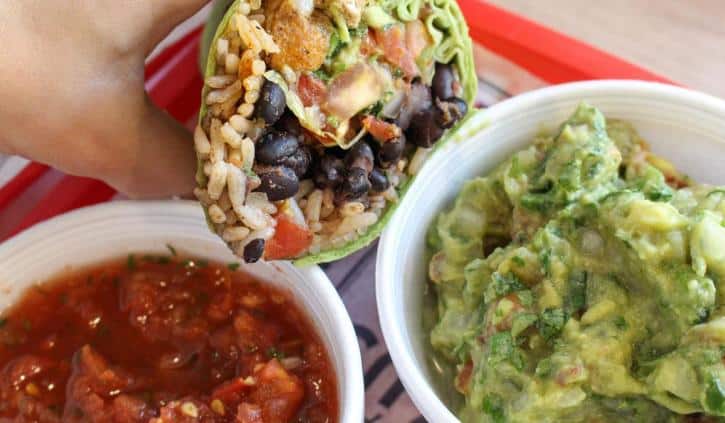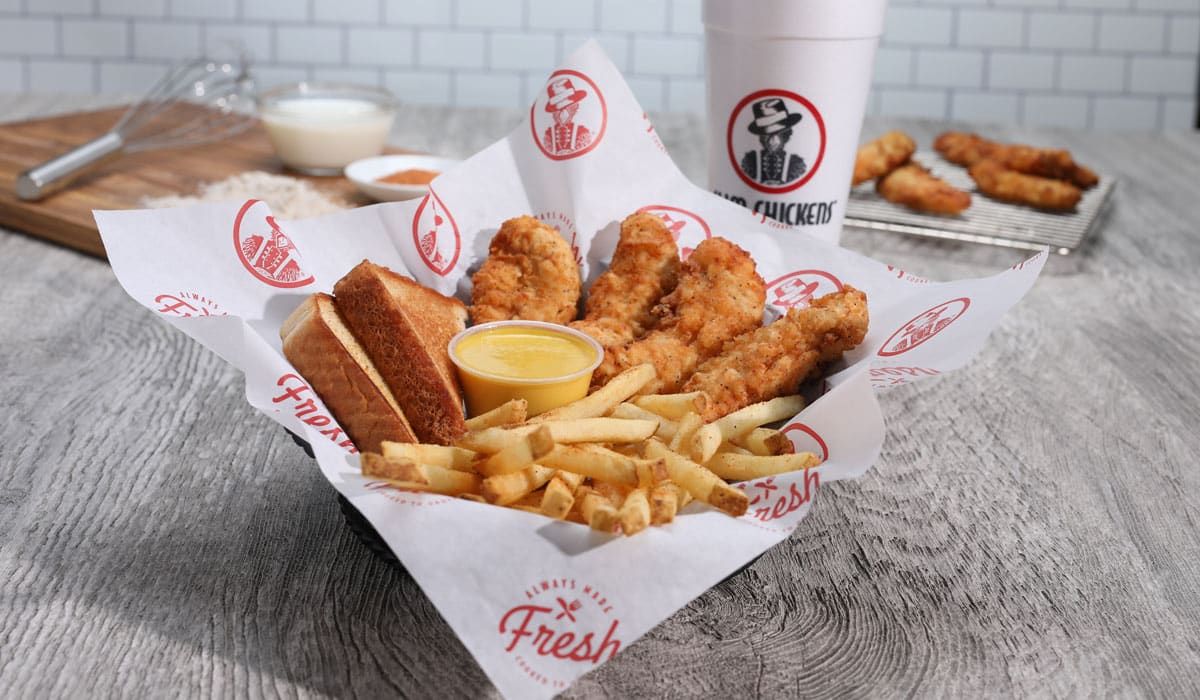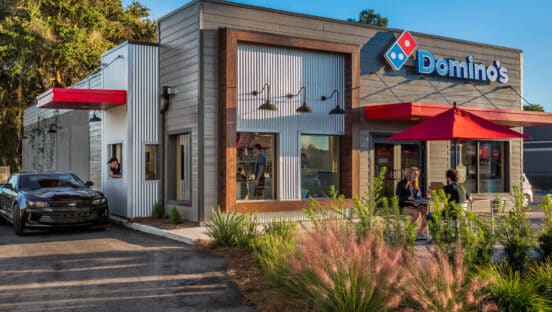








At this point last year, Slim Chickens was on a roll. The Fayetteville, Arkansas–based brand had opened more than 100 restaurants and had 29 debuts planned for 2020, as well as dozens of additional deals in its development pipeline.
Then COVID-19 slammed the brakes on the momentum.
“People took a wait-and-see approach,” says Slim Chickens vice president of franchise development Jackie Lobdell.
As Slim Chickens quickly responded to the pandemic’s tumult, doubling down on efficiencies in its drive thrus and cultivating safe, speedy service, store performance stabilized and then surged. Prospective franchisees, meanwhile, took note and forged ahead with their development deals. After opening 15 stores in 2020, the chain plans to open more than 60 stores in 2021.
“A lot of well-capitalized franchise restaurant groups recognize the opportunity out there, so they’re signing on with us,” Lobdell says.
When it comes to franchising, many quick-service brands carry an optimistic tone into 2021, though they simultaneously acknowledge some interesting changes spurred by a global pandemic that has ignited uncertainty, urged reflection, and altered the calculus of those evaluating quick-service franchises. Here are eight ways that franchises are adapting to the pandemic with one eye on future growth.
Drilling down on the numbers
To be certain, the numbers always mattered. Prospective franchisees have long examined key metrics like ROI and AUV before signing deals. But now, given the risk and uncertainty COVID-19 put on everyone’s platter, franchisees are especially putting brands through the due diligence ringer.
“These folks aren’t in business for their personal health,” Lobdell says. “Ultimately, they want to make money.”
At Wienerschnitzel, the Irvine, California–based hot dog chain with more than 300 stores across 10 states, director of franchise development Ted Milburn openly touts the company’s impressive 2020 output, including a 22 percent average sales increase across the brand from May 1 to October 31. Capitalizing on its drive thrus, All-American comfort food, and low food costs, Milburn eagerly shows interested franchisees real-world results.
“We had a number of franchise owners experience record-high sales, and that makes for a compelling, meaningful story,” he says.
Keeping a critical eye on support
After diving into the numbers, many interested franchisees are also probing the support that a brand provides. While franchisees always expect cooperation from the corporate office, they are more tuned in than ever to the support and service a franchisor offers and desire a partnership rooted in responsiveness and collaboration.
Facing COVID-19’s curveball, the 75-unit Vitality Bowls chain held weekly phone calls with franchisees focused on helping them endure the pandemic. The company provided materials to help individual stores hit on safety measures, shared financial and operational information, and fed franchisees tangible direction on how to corral sales, such as leveraging digital avenues, loyalty, and donation programs.
“Franchisees want a business in a box, and they lean on us for that support,” Vitality Bowls chief operating officer Dave Malinowski says. “And as times get tough, that magnifying glass gets even larger.”
Capitalizing on real estate
The pandemic has stimulated a favorable commercial real estate market for buyers and lessees. As a result, franchisors have been touting real estate opportunities such as second-generation stores and the ability to land favorable terms or high-visibility spaces as reasons to jump into the quick-service game sooner rather than later. By and large, brands are finding savvy franchisees keenly aware of the possibilities and actively looking to pounce on promising deals to diminish risk.
“Landlords are out there looking to get spaces filled, so there are deals to be had addressing a significant fixed cost our operators face,” Malinowski says, adding that Vitality Bowls has numerous prospects in its development pipeline already checking out real estate options. “They’re not naïve to the opportunity to land a better location or to secure better terms.”
Within that real estate orbit, FOCUS Brands CEO Jim Holthouser also sees accelerating interest in cobranded stores, wherein one location houses two or three franchised concepts under its roof. Though pairing a Jamba with a Cinnabon and/or Auntie Anne’s, for example, adds some operational complexity, it also allows operators to cast a wider net into the marketplace from a single piece of real estate.
“One location can serve multiple needs with different franchises, including distinct dayparts or customers who crave different flavors or foods,” says Holthouser, whose Atlanta-based enterprise also oversees established quick-service names such as Moe’s Southwest Grill, Schlotzsky’s, and McAlister’s Deli.
Wanting brands that can flex
The pandemic forced quick-service brands to shift quickly to meet evolving market needs related to consumer preferences or government mandates. And many responded in earnest.
Within days of the World Health Organization declaring COVID-19 a global pandemic on March 11, Slim Chickens had sent updated operational and training procedures to its stores, activated curbside pickup, and provided signage and tents to restaurants. In the drive thru, Slim Chickens adjusted its site layout to accommodate longer stacks, instituted jump lines, and even experimented with kiosks. Those swift changes, paired with the company’s already existing online-ordering platform and national contracts with delivery partners, quickly restored Slim Chickens’ sales.
“In this environment, there was no choice but to be nimble and pivot,” Lobdell says. “Franchisees are looking to brands that have shown they can adapt with the technology and systems to handle any challenges the world might throw at them.”
With the pandemic prompting so much lingering uncertainty (How will dine-in traffic respond? How will the economy fare? What impact will a vaccine have?), interested franchisees are favoring inventive, solutions-oriented companies. In fact, that has driven FOCUS Brands to redraw many of its prototypes—“If they didn’t have drive thrus before, they do now,” Holthouser says—and explore alternative locations, including mobile units for brands like Cinnabon and Auntie Anne’s that have long called shopping malls and other nontraditional venues home.
Other concepts continue investigating ghost kitchens, as well as new dining room–less prototypes featuring takeout windows, cubbies for mobile pickups, dual drive thrus, and outdoor seating. By and large, franchisees want to see brands adjusting to the market and developing distinct, relevant ways to service customers and gain sales beyond the traditional brick-and-mortar experience.
“Franchisees are asking more about this, and they’re definitely penciling out their different options,” Holthouser says.
Seeing a deeper prospect pool
At Wienerschnitzel, Milburn details swelling interest from possible franchise partners.
“They see a line of cars out the street and see the potential,” he says. “They understand what’s working in the market right now.”
The first wave of post-pandemic inquiries to Wienerschnitzel came from existing fast-casual operators eager to apply their resources to a brand thriving in a pandemic world—especially one offering the convenience and sales potential of a drive thru.
“Most of these folks are looking to expand their portfolio and are getting a jump on the next opportunity because they understand it takes time to go through the vetting process and open a store,” Milburn says.
After that, Milburn received a second wave of inquiries from an unexpected group: investors outside the restaurant industry. Given the realities of their existing businesses—maybe they were involved in fitness centers or real estate, for instance—many wanted businesses positioned for long-term success. An established and nimble quick serve like Wienerschnitzel fit the bill.
“Our pipeline is filled with people outside of the restaurant industry who have seen a life-altering event and are assessing opportunities for themselves and their community,” Milburn says. “They see a brand like ours as one that’s unique with some staying power and feel it’s a good bet.”
At Vitality Bowls, Malinowski has similarly noticed rising interest from non-restaurant entrepreneurs, including professional business folks and management types exploring franchising as an alternative to employment.
“With the economy shaken, they don’t want their fate resting in someone else’s hands,” Malinowski says. “They want to control their own destiny and understand people will always need to eat, which has led to more people entertaining [quick-service] franchising.”
Increasing international appetite
The rather solid performance of U.S. quick serves amid the pandemic has intensified interest in quick-service franchises abroad. Holthouser, in fact, notes a healthy appetite for U.S. brands around the world.
At FOCUS Brands, where about 25 percent of the nearly 6,500 units in the company’s portfolio sit outside the U.S., international growth is running seven to eight times faster than domestic growth, Holthouser says.
“Our brands have runway in the U.S., but American brands are popular elsewhere … and I suspect this will become more intense in the coming years,” he says, citing particularly heavy interest in areas across the Middle East and Asia.
Wooing the newbies
Over recent years, Barberitos founder and CEO Downing Barber found many foodservice entrepreneurs, particularly those from the millennial set, most interested in creating their own concept. Tapping into a franchise system lacked a certain amount of sexiness, Barber contends. The pandemic, however, demonstrated the value of a franchise, especially those that adapted and supported their franchise partners.
Throughout 2020, Barberitos “poured money into technology,” Barber says, including app development, online orders that sync with in-store POS systems, and third-party delivery. As a result, Barberitos’ 50 stores enjoyed a vested partner fighting alongside them to steady performance amid a challenging environment.
“I think more folks are opening to the idea of franchising because they can join a system that’s survived and knows how to do it,” Barber says. “They see they don’t have to go at it alone.”
Assessing a brand’s technological backbone
Finally, many prospective franchisees are assigning an even higher priority to a system’s technological backbone from back-office and kitchen tools to consumer-facing mobile apps and online ordering. Having such technologically charged capabilities signals a modern, sophisticated operation moving with consumers and providing operators worthwhile tools to succeed.
“The pandemic accelerated the move to all things digital, and we’re only going to see more of it,” Holthouser says.
That’s especially true on the consumer side, where rampant adoption of technology has supercharged the way in which brands and consumers interact. No longer limited to dine-in or drive-thru traffic, brands touch consumers today through multiple channels, from third-party delivery and mobile apps to curbside pickup. Technology enables restaurant brands to provide the optionality customers crave and to deliver for their franchise partners.
“Talk to many of our franchisees and they’d tell you that without our technology and apps, a different story would be written about their performance in 2020,” Holthouser says.








